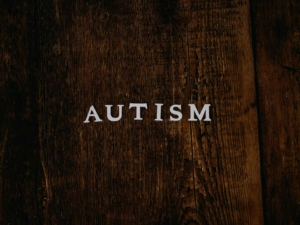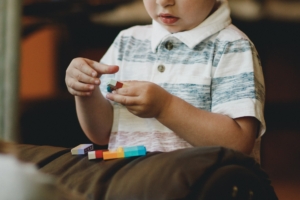 According to the Mayo Clinic, Autism Spectrum Disorder (ASD) describes a neurodevelopmental disorder which affects how a person perceives and responds to others in social situations.
According to the Mayo Clinic, Autism Spectrum Disorder (ASD) describes a neurodevelopmental disorder which affects how a person perceives and responds to others in social situations.
People with ASD often have problems with social communication and interaction with others, which can cause issues in forming and maintaining relationships with others. ASD is often accompanied by repetitive and limited patterns of behavior, and people with ASD will also often have different ways of moving, paying attention and learning.
The term “spectrum” in Autism Spectrum Disorder refers to the wide range of symptoms that individuals experience and the disparity in the severity of those symptoms. According to the American Psychiatric Association’s Diagnostic and Statistical Manual of Mental Disorders (DSM-5TR), ASD will affect a person’s ability to function at work, in school, and other areas of life.
ASD is a complex disorder and, while the current research has not ascertained precisely what causes ASD, there is not sufficient evidence to directly link vaccines as the cause, as many once suspected.
Symptoms of Autism Spectrum Disorder (ASD) in children.
Although autism can be diagnosed at any age, it is described as a developmental disorder because symptoms commonly appear in the first two years of life. A child’s parent, caregiver or pediatrician may start to pick up on early signs of ASD before a child reaches one year of age.
While symptoms typically become more consistently observable by the time a child is two or three years old, each child is likely to have a unique pattern of behavior and level of severity to his or her symptoms.
child is likely to have a unique pattern of behavior and level of severity to his or her symptoms.
Each baby develops at his or her own pace, and so you shouldn’t expect your child to precisely follow a strict developmental timeline. That being said, a child with ASD will show some signs of delayed language skills and social interaction before he or she is years old. Your doctor may recommend tests to identify any cognitive, language and social skills delays if the child:
- Loses language skills or social skills at any age.
- Doesn’t respond with a smile or happy expression by 6 months.
- Doesn’t mimic sounds or facial expressions by 9 months.
- Doesn’t babble or coo by 12 months.
- Doesn’t gesture (pointing or waving) by 14 months.
- Doesn’t say single words by 16 months.
- Doesn’t play “make-believe” or pretend by 18 months.
- Doesn’t say two-word phrases by 24 months.
Each child may have a unique mix of symptoms which will impact the child with differing levels of severity. Some children will have difficulty learning, while others will learn easily enough but struggle to communicate and apply what they are learning.
Social symptoms of ASD in adults and children.
ASD affects a person’s ability to communicate and interact with others in social situations. It often results in repetitive behaviors and restricted interests. The symptoms of ASD will thus often reflect these behaviors, and some of those symptoms include the following:
Adults or children with autism spectrum disorder will show some of the following signs of social communication and interaction behaviors that may include:
- Failure or being slow to respond to his or her name and may appear not to hear you at times.
- Lacking a proficiency in using non-verbal gestures.
- Poor or inconsistent eye contact.
- Lacking facial expression.
- Struggles with sharing interests or emotions with others.
- Having difficulty appreciating one’s own & others’ emotions, and struggling to recognize nonverbal cues such as facial expression, tone of voice or posture.
- Interpreting abstract ideas literally, or repeating words or phrases verbatim without understanding how to use them.
- Resisting cuddling and holding.
- Preferring playing alone and retreating into his or her own world.
- Difficulties adjusting his or her behavior to match social situations.
- Displaying facial expressions and gestures that do not match the circumstances and what’s being said.
- Not picking up on social cues such as not interrupting or waiting for his or her chance to speak.
- Appearing not to look at or listen to people who are talking.
- Having difficulties with the back and forth of conversation, and struggles to start a conversation or keep one going.
- Failure to understand simple questions or directions.
- Speaking with an unusual tone of voice that may sound singsong or flat and robot-like.
- Difficulties sharing in imaginative play or in making and keeping friends.
Behavior patterns of ASD in adults and children.
Some of the patterns of behavior that may indicate ASD include the following:
- Echolalia, or repeating words or phrases.
- Difficulty coping with change in routine or dealing with new experiences and getting upset if there’s a slight change in routine.
- Not engaging in imitative or make-believe play.
- Fascination with moving objects or parts of objects, but struggling to understand the overall function of the object.
- Being more sensitive or less sensitive than other people to sensory input such as light, touch, sound, pain, or temperature.
- Intense interest in specific or niche subjects and fixating on an object or activity with abnormal intensity or focus.
- Performing repetitive movements such as rocking, spinning or hand flapping.
- Performing activities that could cause self-harm such as biting or head-banging.
Challenges of living with ASD.
Having ASD brings certain challenges with it, including needing support at work or school. Depending on where one is on the spectrum and the severity of one’s symptoms, the levels of support needed will vary.
 Relationships can be difficult at the best of times. Due to ASD, one might misread social situations entirely, coming off either as being offensive or dismissive toward others. Additionally, people with ASD will often be prone to sensory overload, making it hard to be in social situations that are noisy, crowded, or too bright. That makes activities like being at a shopping center, restaurant or the movies difficult. Unfortunately, that’s where many people go to bond, share common experiences, and build friendships. This makes it even harder for the person with ASD to form and maintain those meaningful relationships.
Relationships can be difficult at the best of times. Due to ASD, one might misread social situations entirely, coming off either as being offensive or dismissive toward others. Additionally, people with ASD will often be prone to sensory overload, making it hard to be in social situations that are noisy, crowded, or too bright. That makes activities like being at a shopping center, restaurant or the movies difficult. Unfortunately, that’s where many people go to bond, share common experiences, and build friendships. This makes it even harder for the person with ASD to form and maintain those meaningful relationships.
Diagnosis and treatment options for Autism Spectrum Disorder.
It is important to get a proper diagnosis from a doctor. Knowing what the symptoms are is just a way of informing you so that you can ask your doctor questions if you have concerns for yourself or your child. Your doctor or a mental health professional will be able to make the appropriate assessments to determine whether an ASD diagnosis is warranted.
Diagnosis in young children is often a two-stage process. In the first stage, regular well-child checkups with a pediatrician or an early childhood health care provider track a child’s development. The American Academy of Pediatrics recommends that all children ought to receive screening for developmental delays at their 9-, 18-, and 24- or 30-month well-child visits, with specific autism screenings at their 18- and 24-month well-child visits.
In the second stage, if there are any hints of developmental delays, a team of health care providers who have experience diagnosing ASD will conduct the diagnostic evaluation.
This team may include child psychologists and psychiatrists, child neurologists, developmental pediatricians, speech-language pathologists, educational specialists, and occupational therapists. Early detection and diagnosis of ASD will give a child his or her best chance to overcome various challenges.
For adults, the process of diagnosing ASD is often more difficult than diagnosing ASD in children. This is because some ASD symptoms overlap with symptoms of other mental health disorders such as attention-deficit/hyperactivity disorder (ADHD) or anxiety disorders. Adults can be referred to a neuropsychologist, psychologist, or psychiatrist with experience in addressing ASD.
This specialist will study sensory issues, repetitive behaviors, restricted interests, as well as social interaction and communication challenges. Caregivers and family members may also be consulted to learn about the patient’s developmental history for an accurate diagnosis.
If you or your child are diagnosed with ASD, your doctor may make recommendations about treatment options. These may include:
- Speech-language therapy.
- Behavioral Management therapy.
- Occupational therapy.
- Cognitive Behavioral Therapy.
- Physical therapy.
- Educational and school-based therapies.
- Social skills training.
- Medication.
There is currently no one standard treatment for ASD. While most people with ASD respond best to highly structured and specialized programs, the most effective therapies and interventions will often differ for each person. If you have a question about treatment, talk to a therapist or health care provider who specializes in caring for people with ASD.
“Autism”, Courtesy of Annie Spratt, Unsplash.com, CC0 License; “Playing with Legos”, Courtesy of Caleb Woods, Unsplash.com, CC0 License; “Concern”, Courtesy of Jacklyn Moy, Unsplash.com, CC0 License; “Reaching Out”, Courtesy of Youssef Naddam, Unsplash.com, CC0 License









